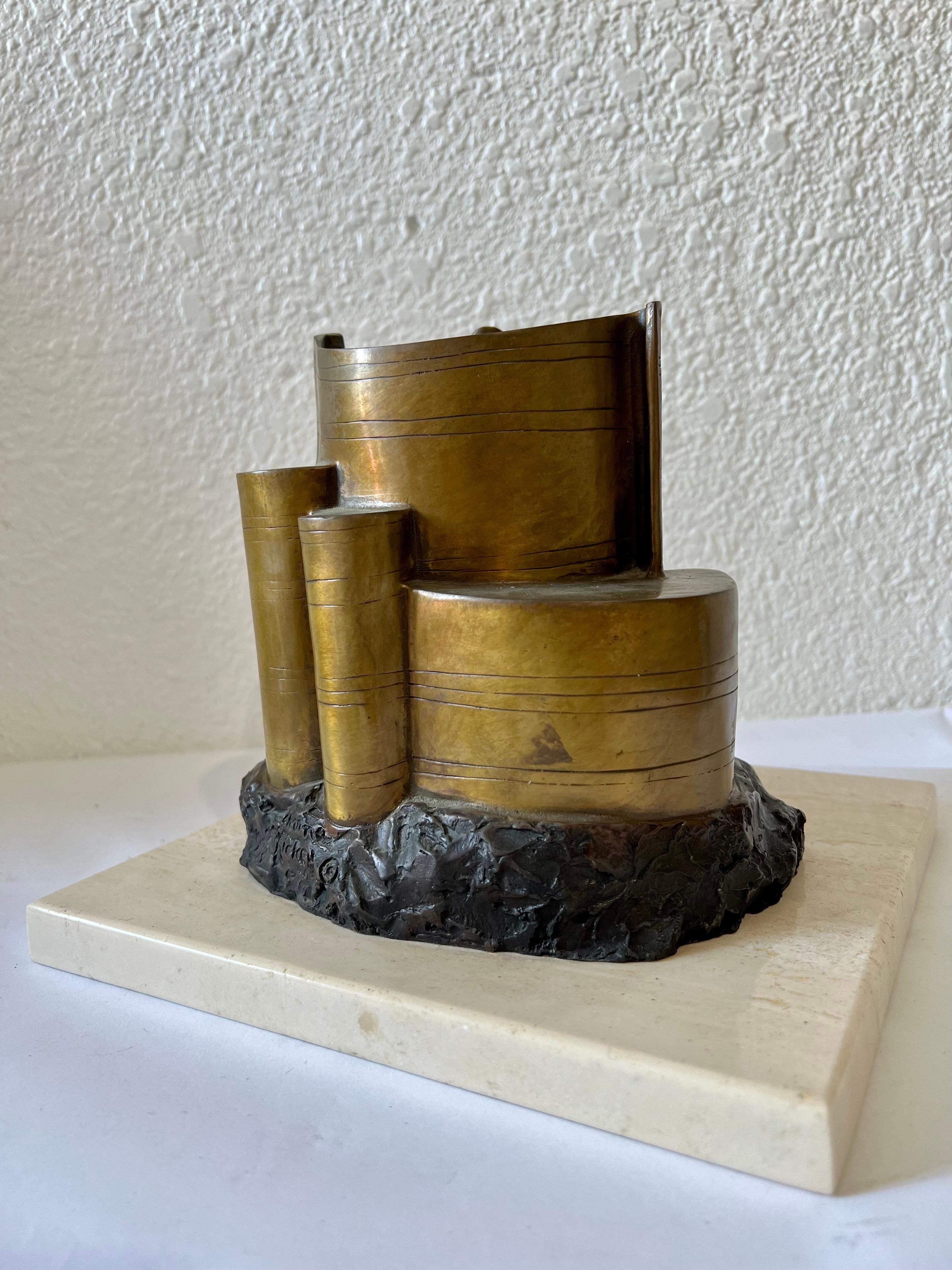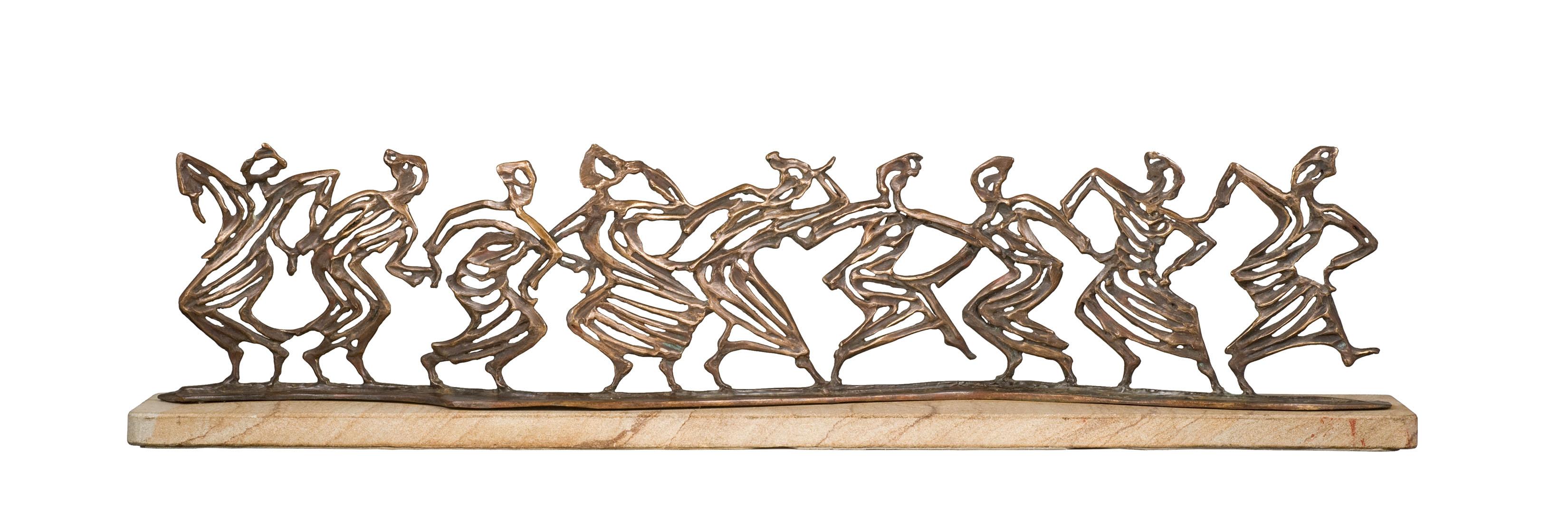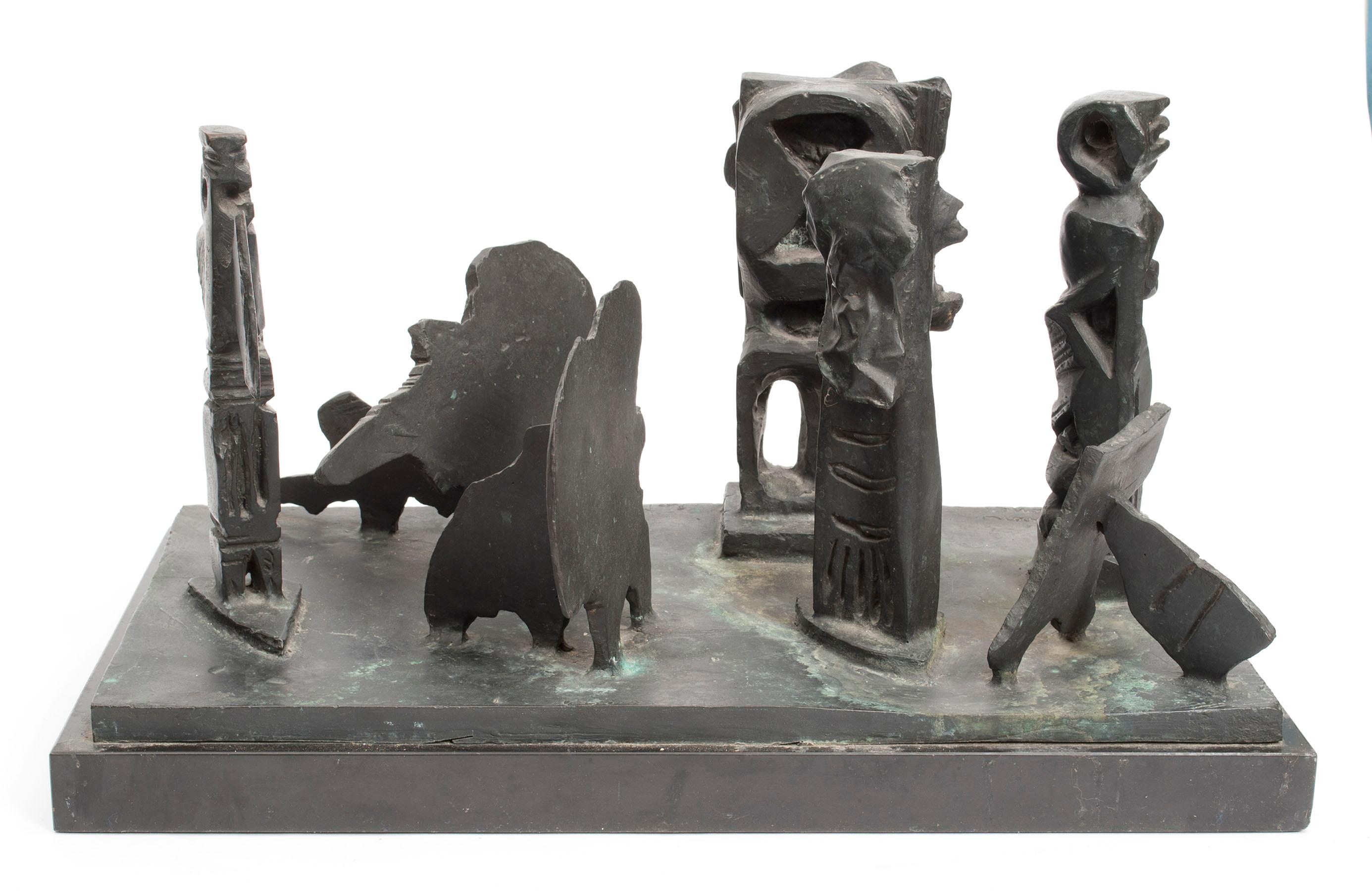Items Similar to Bronze Architectural Model Sculpture Tempio Bretton Architecture Maquette
Want more images or videos?
Request additional images or videos from the seller
1 of 6
Walter Dusenbery Bronze Architectural Model Sculpture Tempio Bretton Architecture Maquette
About the Item
TEMPIO BRETTON: from the catalogue MONUMENTA, 19th International Sculpture Biennale, Antwerp, Belgium.
Tempio Bretton was created in homage to the celebrated English landscapist Capability Brown for the occasion of an exhibition at Bretton Hall in the Yorkshire Sculpture Park , a park in the style of the great master of English garden design. The inclusion in the English garden of a temple ruin, or "eye-catcher," (architectural folly) was used to draw the eye and mind to a focus in time and space, present the beholder with an immediate relationship to an historic past made new within his or her own surroundings, and create a depth of space never before seen in garden design.
I took the idea of the temple ruin eye-catcher and reduced it to a scale at the point where architecture and sculpture merged. Tempio Bretton is not capacious enough to walk into, yet it is considerably larger than a man.
One view of it presents a knot of golden columns clustered together, topped by a dome shape. The only clue from this side to the temple's non-conformity to historic principle is a sharp notch cut into the square base.
Viewed from the opposite side, the cluster of columns capped by an angular top opens up as if to welcome someone in, yet the mysterious core is still impenetrable. These contradictions articulate a confrontation between past and present, and an exciting truth. The past is always at the heart of our constructions in the present.
Walter Dusenbery (born September 21, 1939 in Alameda, California) is an American sculptor. He attended the San Francisco Art Institute, earned an MFA from California College of Arts and Crafts, and then studied in Japan and Italy under Isamu Noguchi. He also held teaching positions at Harvard University and University of California, Berkeley Graduate School of Design. From 1971 to 1988, he lived both in Pietrasanta,Italy, and in Little Italy, New York City. Dusenbery's preferred material is stone, particularly travertine or granite. Dusenbery has a particular interest in adding sculpture to public places, such as federal buildings, to humanize the space, but in 1988, he assembled a show of small, entirely hand-carved alabaster sculptures, called "Walter Dusenbery, The Personal Side," at the Fendrick Gallery in Washington, D.C.. In 1977, Dusenbery created Pedogna, on permanent loan from The Metropolitan Museum of Art to Landmarks, the public art program of The University of Texas at Austin.
That same year, 1988, he was awarded a large commission for the Fulton County Building Atrium in Atlanta, Georgia. The commission was for three fountains and related structures over three stories in height, designed for informal and ceremonial public events, Limestone, marble, granite and travertine fountains, pavilions, seating and meeting areas, performance and concert platforms, staircases and planters for hanging gardens. After completion of the "Atlantacropolis," Dusenbery withdrew from the gallery world and focused his energy on site-specific commissions. (like the landscape works of Maya Lin and Beverly Pepper) Seeking a large-scale stone studio for projects closer to home, he discovered there were none. In 1995, he approached sculptor and patron of sculpture J. Seward Johnson Jr. with the idea of creating a state-of-the-art stone-carving studio, so that American sculptors would not have to travel abroad to realize their work. Johnson agreed to fund such a facility, if Dusenbery would direct it. In 1996, Dusenbery designed the facility for the Stone Division at Johnson Atelier Technical Institute of Sculpture, and was its first director. The facility was situated in "a building resembling an airplane hangar," The studio offered the ability to digitally scan three-dimensional forms. The Stone Division was a success and attracted a strong group of sculptors: Magdalena Abakanowicz, Lawrence Argent, Barry X Ball, Jon Isherwood, and Manolo Valdes, to name a few. It was redeveloped as the Digital Stone Project by the clients of the Stone Division as a not-for-profit in 2004. Dusenbery was named President of the Board and remained in that position until 2008.
Dusenbery was given Stone World's "Technological Achievement Award" in 1999, which recognizes stone workers who innovate, share, and promote new technologies in the industry.
Other awards include the 1985 Augustus Saint-Gaudens Memorial Prize in 1985, Deutscher Akademischer Austausch Dienst in 1982, National Endowment for the Arts Fellowship in 1981 and Creative Arts Service Grant in 1980.
SELECTED PUBLIC COLLECTIONS:
Metropolitan Museum of Art , NY
Guggenheim Museum , NY
San Francisco Museum of Art , CA
Columbus Museum of Fine Art, OH
Laumeier Int'l Sculpture Park , St. Louis , MI
Yorkshire Sculpture Park , England
Gulbenkian Foundation, Lisbon , Portugal
Jerusalem Foundation , Israel
Commune of Glostrup, Copenhagen , Denmark
Prudential Insurance Company, Boston , MA
Grounds for Sculpture Museum and Park, Hamilton , NJ
- Creator:Walter Dusenbery (1939)
- Dimensions:Height: 12.5 in (31.75 cm)Width: 3.5 in (8.89 cm)Depth: 3.5 in (8.89 cm)
- Medium:
- Movement & Style:
- Period:
- Condition:
- Gallery Location:Surfside, FL
- Reference Number:1stDibs: LU3827668402
About the Seller
4.9
Platinum Seller
These expertly vetted sellers are 1stDibs' most experienced sellers and are rated highest by our customers.
Established in 1995
1stDibs seller since 2014
1,549 sales on 1stDibs
Typical response time: 1 hour
- ShippingRetrieving quote...Ships From: Surfside, FL
- Return PolicyA return for this item may be initiated within 3 days of delivery.
More From This SellerView All
- Bronze Abstract Space Age Book Sculpture LA California Modernist Charna RickeyBy Charna RickeyLocated in Surfside, FLCharna Rickey 1923 - 2000 Mexican-American Jewish Woman artist. Signed Bronze House of Books, Architecture Bronze sculpture, signed Charna Rickey and on the front "House of the book." It depicts an open Torah. Original patina. Approx. dimensions: 7 in. H x 9 in. W x 8.5 in. D. Weight: 13.1 lbs. Modernist Judaica Sculpture Born Charna Barsky (Charna Ysabel or Isabel Rickey Barsky) in Chihuahua, Mexico, the future artist lived in Hermosillo and immigrated to Los Angeles when she was 11. She was educated at UCLA and Cal State L.A., she married furniture retailer David Rickey and explored art while raising their three daughters. Moving through phases in terra cotta, bronze, marble and aluminum, she found success later in life. Rickey became one of the original art teachers at Everywoman's Village, a pioneering learning center for women established by three housewives in Van Nuys in 1963. She also taught sculpture at the University of Judaism from 1965 to 1981. As Rickey became more successful, her sculptures were exhibited in such venues as Artspace Gallery in Woodland Hills and the Courtyard of Century Plaza Towers as part of a 1989 Sculpture Walk produced by the Los Angeles Arts Council. Her sculptures have also found their way into the private collections of such celebrities as Sharon Stone. Another of Rickey's international creations originally stood at Santa Monica College. In 1985, her 12-foot-high musical sculpture shaped like the Hebrew letter "shin" was moved to the Rubin Academy of Music and Dance at Hebrew University in Jerusalem. The free standing architectural Judaic aluminum work has strings that vibrate in the wind to produce sounds. Rickey also created art pieces for the city of Brea. They commissioned some amazing art pieces by Laddie John Dill, Walter Dusenbery, Woods Davy, Rod Kagan, Pol Bury, Niki de Saint Phalle, Magdalena Abakanowicz, Larry Bell, John Okulick...Category
20th Century American Modern Abstract Sculptures
MaterialsMarble, Bronze
- The Test, Assembled Kinetic Modernist Sculpture Puzzle ConstructionBy William King (b.1925)Located in Surfside, FL"The Test," 1970 Aluminum sculpture in 5 parts. Artist's cipher and AP stamped into male figure, front, 20 5/16" x 12 1/2" x 6 5/7" (approx.) American sculptor King is most noted for his long-limbed figurative public art sculptures depicting people engaged in everyday activities such as reading or conversing. He created his busts and figures in a variety of materials, including clay, wood, metal, and textiles. William Dickey King was born in Jacksonville, Florida. As a boy, William made model airplanes and helped his father and older brother build furniture and boats. He came to New York, where he attended the Cooper Union and began selling his early sculptures even before he graduated. He later studied with the sculptor Milton Hebald and traveled to Italy on a Fulbright grant. Mr. King worked in clay, wood, bronze, vinyl, burlap and aluminum. He worked both big and small, from busts and toylike figures to large public art pieces depicting familiar human poses — a seated, cross-legged man reading; a Western couple (he in a cowboy hat, she in a long dress) holding hands; a tall man reaching down to tug along a recalcitrant little boy; a crowd of robotic-looking men walking in lock step. Mr. King’s work often reflected the times, taking on fashions and occasional politics. In the 1960s and 1970s, his work featuring African-American figures (including the activist Angela Davis, with hands cuffed behind her back) evoked his interest in civil rights. But for all its variation, what unified his work was a wry observer’s arched eyebrow, the pointed humor and witty rue of a fatalist. His figurative sculptures, often with long, spidery legs and an outlandishly skewed ratio of torso to appendages, use gestures and posture to suggest attitude and illustrate his own amusement with the unwieldiness of human physical equipment. His subjects included tennis players and gymnasts, dancers and musicians, and he managed to show appreciation of their physical gifts and comic delight at their contortions and costumery. His suit-wearing businessmen often appeared haughty or pompous; his other men could seem timid or perplexed or awkward. Oddly, or perhaps tellingly, he tended to depict women more reverentially, though in his portrayals of couples the fragility and tender comedy inherent in couplehood settled equally on both partners. His first solo exhibit took place in 1954 at the Alan Gallery in New York City. King was elected to the American Academy of Arts and Letters in 2003, and in 2007 the International Sculpture Center honored him with the Lifetime Achievement in Contemporary Sculpture Award. Mr. King’s work is in the collections of the Metropolitan Museum of Art, Guggenheim Museum, Whitney Museum and the Museum of Modern Art in New York and the Hirshorn Museum at the Smithsonian American Art Museum in Washington, among other places, and he had dozens of solo gallery shows in New York and elsewhere. Reviews of his exhibitions frequently began with the caveat that even though the work was funny, it was also serious, displaying superior technical skills, imaginative vision and the bolstering weight of a range of influences, from the ancient Etruscans to American folk art to 20th-century artists including Giacometti, Calder and Elie Nadelman. The New York Times critic Holland Cotter once described Mr. King’s sculpture as “comical-tragical-maniacal,” and “like Giacomettis conceived by John Cheever.”Category
1970s American Modern Figurative Sculptures
MaterialsMetal
- Helen Shirk Sculpture Hand Crafted Studio Vessel, Copper Patina, Colored PencilsLocated in Surfside, FLTitle: Red Pod, CV110V, San Diego, 1997 Fabricated, hammered copper, colored pencils, patina. This is not signed. It bears a label on the interior and the artist has kindly confirmed the attribution to me. Helen Shirk...Category
1990s American Modern Abstract Sculptures
MaterialsCopper
- Brutalist Modern Abstract Bronze Sculpture Metropolis Manner of Louise NevelsonBy Abbott PattisonLocated in Surfside, FLA very heavy, massive bronze sculpture by an important Chicago sculptor. Signed and marked "Firenze" with "Fuse Marinelli". METROPOLIS. Seven abstract shapes on black marble base. 1...Category
20th Century Modern Abstract Sculptures
MaterialsMarble, Bronze
- Large Bronze Modernist Biomorphic Sculpture Abstract Bird Colin Webster WatsonLocated in Surfside, FLColin Webster Watson (1926-2007). A patinated cast bronze sculpture of a stylized bird with a steel ring. Signed, numbered and dated (1985). With a Tallix foundry mark. Measu...Category
1970s Modern Abstract Sculptures
MaterialsBronze, Stainless Steel
- Cast Bronze Organic Husk Wall Mounted Abstract Textured Sculpture Seena DonnesonBy Seena DonnesonLocated in Surfside, FLThis is an abstract Flora based hand made, cast sculpture done by Seena Donneson an acclaimed woman artist. A textured abstract bronze with deep, rich patina; The sculpture is signed...Category
21st Century and Contemporary Modern Abstract Sculptures
MaterialsBronze
You May Also Like
- Virasat Curved, figurative bronze mantle pieceBy Robert CookLocated in Greenwich, CTA remarkable and unique format bronze of unique cast that could be great for a mantle or console table. In Robert Cook's book entitled “Waxing and Waning” he discusses three castings...Category
Early 2000s American Modern Abstract Sculptures
MaterialsStone, Bronze
- Black Falling Man with FormBy Ernest Tino TrovaLocated in Missouri, MOErnest Tino Trova "Black Falling Man with Form" 1996 Bronze Ed. 1/3 Signed, Dated and Numbered Verso approx. 16 x 8.5 x 16 inches Known for his Falling Man series in abstract figura...Category
1990s American Modern Figurative Sculptures
MaterialsBronze
- Younger brotherBy Volodymyr TsisarykLocated in Palm Beach, FLBronzeCategory
2010s Modern Abstract Sculptures
MaterialsBronze
- "Draped Figure" Sassafras & Bronze, Figurative Sculpture, 1982Located in Detroit, MI"Draped Figure" is a beautiful example of Tazian's ability to meld the smooth texture of wood and the hard texture of bronze into an exquisite object to view, hold or caress. The piece balances perfectly on its stone base and can be easily turned to enjoy from all angles. Like architects Eliel Saarinan and Albert Kahn and sculptor Corrado Parducci, Tazian is an immigrant creative who has found a home in the city, nurtured by its energy and sheltered by its community. He developed an early ambition to become an artist, even though he had very little exposure to the arts. ““The only person [who encouraged me] was my 5th grade English teacher, Olivia Balian,” he says. “She really opened the doors of art for me. She said, ‘Those students who are interested in art can stay behind after school and I will show you how to paint and draw.’ Somehow [that] changed my life– she gave me that spark.” Tazian came to the U.S. to study at St. Francis College in Fort Wayne, Indiana. He earned a bachelor’s degree in art and a Master’s in Art Education, and then earned and MFA in sculpture from Wayne State University in Detroit. Kegham Tazian is an award-winning sculptor and painter. The Armenian-born artist has gained notoriety for the diversity of his work and the variety of media exemplified in his pieces. A blend of modernism, realism and abstraction are commonly depicted in his paintings and sculptures. His artwork has been represented in more than 40 solo exhibitions and more than 75 group exhibitions throughout the United States, Canada, Europe, and the Middle East. His work adorns the entrances and halls of major corporations, universities and municipalities, including Siemens Corporation, Huntington Bank, Wayne State University and the city halls of Farmington and Farmington Hills...Category
21st Century and Contemporary Modern Abstract Sculptures
MaterialsStone, Bronze
- Morris Brose "Bronze Bull" Figurative Sculptural AbstractLocated in Detroit, MISALE ONE WEEK ONLY "Bronze Bull" is an exquisite example of Morris Brose's abstract/figurative sculpture. No soft edges on this piece and no invitation to caress, the power, strength and beauty of the bronze are front and center and create awe. "Bronze Bull" is a free-standing piece signed on the base. Morris Brose, Polish/American was born in Wyszkow, Poland. He became a sculptor and instructor of sculpture at the Detroit Institute of Arts, Wayne State University and Cranbrook Academy of Art, Bloomfield Hills, Michigan. Cranbrook was designed by architect and faculty member, Eliel Saarinen who collaborated with Charles and Ray Eames on chair and furniture design. Numerous creative artists who are alumni of Cranbrook include: Harry Bertoia, Florence Knoll, Jack Lenor Larsen, Donald Lipski...Category
Late 20th Century Modern Abstract Sculptures
MaterialsBronze
- Latin American Raúl Valdivieso Bronze Organic Abstract SculptureBy Raúl ValdiviesoLocated in Washington, DCAppealing bronze organic sculpture by Latin American sculptor Raúl Valdivieso (Chilean, 1931-1993). Valdivieso is known for his reinterpretation of the...Category
1960s Modern Abstract Sculptures
MaterialsBronze
Recently Viewed
View AllMore Ways To Browse
Material Architecture
Architecture Sculpture
Architecture Models
Bronze Architecture
Vintage Architectural Models
Bronze L Sculpture
Modern Danish Sculpture
Large American Bronze
Japan Sculpture Garden
Bronze Garden Sculpture
Modern Sculpture Large Bronze
Modern Hanging Sculptures
Stone Architecture Italy
Garden Gold Sculpture
Portugal Architectural
Abstract Belgian Sculpture
Small Bronze Modern Sculpture
Model Dome





